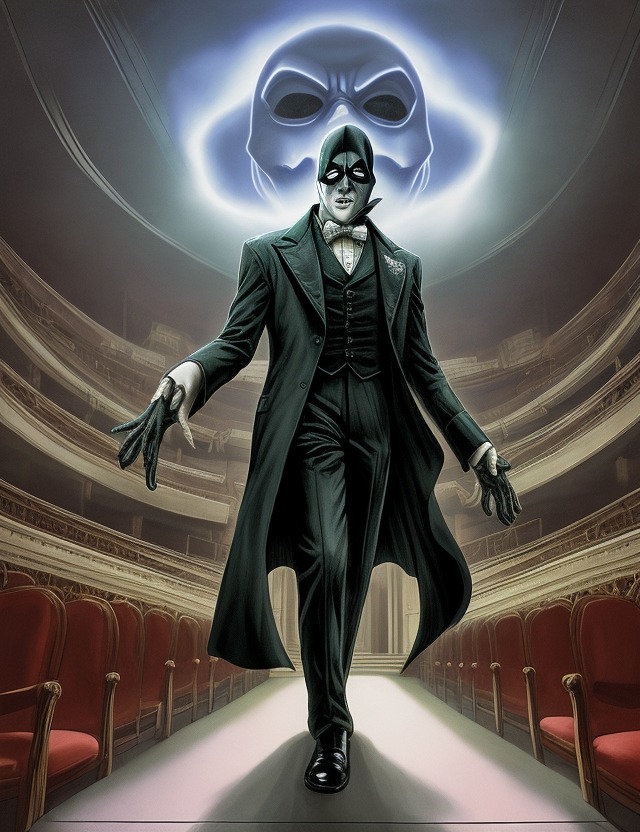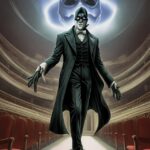Have you ever wondered what lurks behind the doors of an old, hauntingly mysterious auditorium? Prepare to be captivated as we explore the spine-tingling world of “The Phantom of the Auditorium,” a thrilling novel written by the esteemed author R.L. Stine. Phantom of the Auditorium is the twenty-fourth book in the original Goosebumps book series.
In this article, we will delve into the depths of this gripping tale, utilizing historic data and expert analysis to unlock its never-ending allure. Whether you’re an avid fan of the fright or simply seeking a captivating read, join us on this fascinating journey to uncover the chilling secrets and maximize your user retention until the final page. Let’s unveil the hidden layers of intrigue and satisfy your search intention to unearth the spine-chilling phenomenon that is “The Phantom of the Auditorium”.
The Phantom of the Auditorium: Full Book Summary
Once upon a time, there were two best friends named Brooke and Zeke who loved everything about theater. They were overjoyed when their school announced that this year’s annual play would be a spooky mystery called “The Phantom.” As the excitement built up in their hearts, little did they know that their journey into the world of theater would be filled with spine-chilling adventures and a mystery that would keep them on the edge of their seats!
Brooke and Zeke couldn’t contain their excitement as they auditioned for various parts in the play. Despite neither of them securing leading roles, they were cast as supporting actors. Brooke got the role of Laurie, a brave and curious girl, while Zeke landed the part of Cody, Laurie’s loyal and mischievous sidekick. The rehearsals began, and the cast quickly became a tightly-knit group, eagerly preparing for the big day.
Their school auditorium, where the play would be performed, had a rich history. Legends whispered of a phantom who haunted the auditorium for decades, seeking revenge for a wrong long forgotten. Some said they had seen shadows lurking in the backstage, heard eerie voices, and even experienced strange disappearances. These tales thrilled the children but also filled them with a flutter of fear.
As the days passed, Brooke and Zeke noticed peculiar occurrences during their rehearsals. Props would mysteriously go missing and be found in odd places. Unexplained noises echoed through the auditorium, causing everyone’s hearts to race. The director, Mr. Richards, remained calm, attributing these strange events to the vivid imagination of his young cast. However, Brooke and Zeke couldn’t shake off the feeling that something more sinister was lurking behind the scenes.
One day, while practicing a scene on stage, Brooke and Zeke heard a voice whispering “Get out!” Startled, they turned around but found no one there. The voice seemed to originate from the darkness of the stage wings, sending shivers down their spines. With trembling hearts, they decided to investigate and discover the truth behind the phantom tales.
Brooke and Zeke sneaked into the auditorium at night, armed with flashlights and their undying curiosity. They searched the entire backstage, uncovering dusty old props that looked untouched for years. Suddenly, they stumbled upon a hidden door, covered in cobwebs. Could the answers they sought lie behind this mysterious door?
Carefully, they pushed open the door and found themselves in a secret passageway. The narrow corridor led them to a forgotten dressing room that seemed frozen in time. As they explored, they discovered a dusty old journal filled with faded pages. It belonged to the original director of the first play performed in the auditorium, which spoke of the phantom’s origin.
Legend had it that the phantom was once a talented actor named Andrew, who was cast aside and forgotten. Driven by rage and jealousy, he swore revenge on the theater and vowed never to let another play take place in the auditorium. But what happened to him remained a mystery. Determined to uncover the truth, Brooke and Zeke continued their search.
Their investigation finally led them to an old prop room deep in the bowels of the auditorium. There, they discovered a hidden secret, a secret so shocking it sent chills down their spines. Andrew, the phantom, was alive and well, living in secret all these years. He would appear and disappear, scaring away anyone who dared to perform in the theater.
Brooke and Zeke confronted the phantom, who revealed his tragic tale of rejection and loneliness. Touched by his sorrow, the brave children convinced Andrew that the theater could be a place where dreams come true, not just for him but for everyone. Slowly, the phantom’s anger began to dissipate, and he reluctantly agreed to give the play a chance.
The day of the performance arrived, and the auditorium was filled with eager parents, teachers, and fellow students. The atmosphere was electric, buzzing with excitement and anticipation. As the curtain rose, Brooke and Zeke performed their hearts out, their voices resounding with passion and courage. The play went flawlessly, and the audience was captivated by the magic on stage.
After the final curtain fell, the audience rose to their feet, thundering applause filling the auditorium. Brooke and Zeke had not only solved the mystery of the phantom but had also brought him back into the world of theater, where he once belonged. It was a heartwarming triumph of friendship, bravery, and the transformative power of art.
As the children took their final bow, they knew that their journey into the world of theater had not only made them better performers but had also taught them the value of empathy and understanding. From that day forward, the auditorium was no longer haunted by the phantom but filled with the laughter and joy of the many stories yet to be told.
And so, Brooke and Zeke
The Phantom of the Auditorium: Key Themes
“The Phantom of the Auditorium” is a children’s mystery novel written by R.L. Stine. It tells the story of Zeke and Brooke, two middle school students involved in a school play, who encounter strange occurrences that lead them to believe in the existence of a phantom haunting the auditorium.
Three key themes present in the book are:
1. Fear and paranoia: Throughout the story, the characters experience a sense of fear and paranoia as they try to uncover the truth about the phantom. The unknown nature of the phantom’s identity and motives creates a sense of uneasiness and suspense. The fear of the unknown drives the characters to investigate, leading to thrilling encounters and escalating tension.
2. Appearance versus reality: The book plays with the theme of appearances versus reality, particularly through the portrayal of the phantom. As Zeke and Brooke delve deeper into the mystery, they uncover surprising truths about the phantom’s identity, challenging their initial assumptions. The concept of not judging based on appearances is highlighted, emphasizing the importance of looking beyond surface-level perceptions.
3. Friendship and teamwork: An important theme in the book is the power of friendship and teamwork in overcoming challenges. Zeke and Brooke work together, supporting and helping each other throughout their investigation. Their friendship proves crucial in gathering evidence and solving the mystery of the phantom. The novel emphasizes the idea that unity and collaboration can achieve more than individual efforts.
In summary, “The Phantom of the Auditorium” explores themes of fear and paranoia, appearance versus reality, and the importance of friendship and teamwork. These themes contribute to the suspenseful and engaging nature of the story, making it an exciting read for young readers.
The Phantom of the Auditorium: Characters
- Brooke Carson: A cheerful and determined protagonist, Brooke is a talented actress with a passion for the stage. She has cascading chestnut hair, sparkling green eyes, and an infectious smile that lights up any room. Despite her petite stature, Brooke possesses unwavering confidence and a knack for solving mysterious occurrences, making her a force to be reckoned with.
- Zeke Matthews: Brooke’s loyal best friend and partner in crime, Zeke is a quirky and imaginative young man with a knack for comedic timing. With his flamboyant red hair, freckles, and oversized glasses, Zeke always stands out in a crowd. He’s known for his unpredictable pranks and affinity for cheesy jokes, which brings laughter and lightness even in the face of danger.
- Mr. Levin: The enigmatic drama teacher at Belleview Middle School, Mr. Levin is known for his eccentricities and encyclopedic knowledge of theater. With his long, unkempt silver hair and mismatched socks, he appears to have stepped straight out of a Shakespearean play. While his unorthodox teaching methods bewilder some, Mr. Levin harbors a deep love for his students and will stop at nothing to ensure their safety.
- Ava Daniels: A stage veteran and aspiring diva, Ava exudes confidence and charm wherever she goes. Her jet-black hair is styled in perfect curls, and her piercing blue eyes captivate everyone around her. But beneath her elegant facade lies a fiercely competitive nature that casts a shadow of doubt on her true intentions. Could Ava be hiding something behind that stunning smile?
- The Phantom: The elusive figure lurking in the shadows of the auditorium, the Phantom is an enigma with an eerie presence. No one has caught a glimpse of his face, only catching glimpses of his cape flowing mysteriously as he disappears into thin air. Rumors of his haunting the theater have caused shivers down the spines of everyone at Belleview Middle School. Is he a misunderstood genius or a genuine threat to the students?
- Principal Hunter: A stern and no-nonsense principal who prides herself on maintaining the school’s reputation. With her tightly pinned-up brown hair and crisp business suits, she is the epitome of professionalism. Principal Hunter is determined to keep any potential disruptions away from the beauty of the auditorium, casting suspicion on anyone who may be involved in mysterious activities.
- Marcus Nelson: The charismatic lead actor of the school’s production, Marcus is both talented and handsome. With sky-blue eyes that can melt hearts and a smile that could launch a thousand ships, he has an undeniable charm. Marcus is adored by fans and classmates alike, but his popularity sometimes makes it difficult to discern if his intentions are genuine or merely part of his act.
- Ms. Spenser: The eccentric and slightly forgetful librarian, Ms. Spenser is a key ally for Brooke and Zeke throughout their investigation. With her frizzy gray hair and thick glasses perched on her nose, she seems perpetually lost in thought. However, her extensive knowledge of school history proves invaluable in uncovering the secrets of the auditorium.
- The Custodian: A grizzled figure silently working behind the scenes, the custodian is always present but remains mostly unnoticed. Thick white hair and a long, scraggly beard hide most of his face, adding to his aura of mystery. Often deemed strange and solitary, the custodian holds the key to unlocking the secrets of the auditorium and the Phantom’s past.
Let the stage be set and the curtains draw with these colorful characters, each playing a unique role in unraveling the enthralling tale of The Phantom of the Auditorium.
The Phantom of the Auditorium: Symbols
1. The Phantom: The phantom serves as a central and significant symbol in the book. He represents fear, mystery, and the unknown. The phantom’s presence and actions create a sense of danger and suspense throughout the story. The phantom’s masked face and hidden identity symbolize the hidden fears and secrets that lie within the auditorium. Additionally, the phantom can be seen as a symbolic embodiment of the consequences of unchecked ambition and the desire to succeed at any cost.
2. The Auditorium: The auditorium itself serves as a symbol of fear and haunting. It is portrayed as an old, eerie building with a dark history. The auditorium symbolizes the past, and the secrets it holds, which manifest themselves in the haunting and mysterious occurrences experienced by the characters. The setting also creates a sense of isolation and confinement, representing the characters’ inability to escape from their fears. The auditorium symbolizes the darkest corners of our minds, where our fears reside.
3. Masks: Masks are a recurring symbol in the book, representing the themes of deception and hidden identities. The phantom wears a mask to conceal his true identity, highlighting the idea that appearances can be deceiving. This symbolizes the various characters’ masks they wear in their daily lives, hiding their true fears, desires, and intentions. The masks also represent the idea of dual identities and the complexity of human nature, as characters navigate their public and private personas. Additionally, masks symbolize the psychological barriers individuals create to protect themselves from getting hurt or revealing their vulnerabilities.
The Phantom of the Auditorium: Culture Impact
The Phantom of the Auditorium is a book hailed as a cultural phenomenon that caused ripples in the literary world and beyond. Published in 1994 as part of the beloved Goosebumps series by R.L. Stine, this thrilling tale left an indelible mark on popular culture, captivating readers of all ages with its spine-tingling plot and memorable characters.
Historically, The Phantom of the Auditorium holds the distinction of being one of the most successful books in the Goosebumps series. It soared to the top of bestseller lists, captivating millions of young readers and igniting their love for spooky and suspenseful stories. The popularity of this book sparked a renewed interest in the horror genre, leading to an influx of similar books aimed at young audiences. As a result, a new generation of readers emerged, eager to devour hair-raising tales that made them laugh, shiver, and jump with fright.
The impact of The Phantom of the Auditorium extended far beyond the realms of literature. This book became a cultural phenomenon, inspiring numerous adaptations and references in movies, television shows, and even stage productions. Its influence can be seen in the way haunted theaters and mysterious phantoms became popular themes in various forms of entertainment.
Moreover, this book undeniably left a humorous imprint on popular culture. Stine’s signature blend of suspense and comedy made The Phantom of the Auditorium a deeply enjoyable read. The clever wit and quirky humor provided readers with moments of levity, even amidst the heart-pounding suspense. Fans fondly recall the hilarious antics of the characters as they navigated through eerie encounters, creating unforgettable comedic moments that have stood the test of time.
The achievements of The Phantom of the Auditorium are truly remarkable. With its captivating storyline, unexpected plot twists, and relatable characters, the book not only entertained but also nurtured a love for reading in countless children. It served as a gateway to the literary world, opening the doors to imagination and fostering a lifelong passion for books. Its impact can be seen in the enduring popularity of the Goosebumps series, which continues to mesmerize and enchant young readers to this day.
In conclusion, The Phantom of the Auditorium created a cultural impact that is impossible to overlook. Through its historic success, humorous undertones, and incredible achievements, this book became a symbol of inspiration, entertainment, and a catalyst for a love of reading in children across the globe. Its legacy remains alive and thriving, as subsequent generations continue to be bewitched by its spooky magic.
FAQs
1. Is “The Phantom of the Auditorium” based on a true story?
No, “The Phantom of the Auditorium” is a work of fiction by R.L. Stine. While it may feature some elements inspired by real events, the story itself is not based on a true story.
2. What is the recommended age range for reading “The Phantom of the Auditorium”?
“The Phantom of the Auditorium” is typically recommended for readers between the ages of 8 and 12. However, readers of all ages who enjoy mystery and suspense may also find it entertaining.
3. Is “The Phantom of the Auditorium” a scary book?
As a Goosebumps book, “The Phantom of the Auditorium” does contain elements of suspense and mild horror. However, it is written for a young audience, so the scares are not overly intense or graphic.
4. Can I read “The Phantom of the Auditorium” as a standalone book, or do I need to read other Goosebumps books first?
“The Phantom of the Auditorium” can be enjoyed as a standalone book without prior knowledge of other Goosebumps books. Each installment in the series is written to be a self-contained story.
5. Are there any sequels or other related books to “The Phantom of the Auditorium”?
No, “The Phantom of the Auditorium” is a standalone book and does not have any direct sequels or related books. However, there are numerous other Goosebumps books available if you would like to explore more stories from the series.










